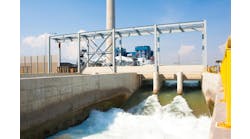In late 2006, Congress passed the Department of Homeland Security Appropriations Act of 2007. Among other things, Congress directed the Department of Homeland Security (DHS) to regulate chemical facilities that present "high levels of security risk." Unlike purely prescriptive regulations, however, Congress required DHS to utilize performance standards, thereby giving regulated facilities greater flexibility to satisfy security mandates. Importantly, Congress exempted certain facilities from regulation, including water and wastewater treatment facilities and those facilities already regulated by the Maritime Transportation Security Act (MTSA). DHS's authority to regulate high-risk chemical facilities had an initial three-year window, set to expire in October 2009.
Pursuant to this congressional authority, DHS published the Chemical Facility Anti-Terrorism Standards (CFATS) on April 9, 2007. It was not until November of that year that DHS released Appendix A to CFATS, which provided a list of more than three hundred Chemicals of Interest (COIs). Unless exempt by statute or rule, any chemical facility operating in the United States that possesses one or more COIs at or above a specific quantity and concentration is required to submit information to enable DHS to decide whether and to what extent a facility may be high-risk.
As the initial CFATS expiration date neared in the fall of 2009, the regulation was not yet fully implemented: DHS was still reviewing Security Vulnerability Assessments and only a fraction of regulated facilities had submitted Site Security Plans. Acknowledging that CFATS must remain the law but lacking a permanent chemical security law, Congress passed the Department of Homeland Security Appropriations Act of 2010, extending CFATS until October 2010.
In the meantime, Congress continues to debate the specific parameters of permanent chemical security legislation. Most recently, on November 9, 2009, the House of Representatives passed H.R. 2868, the Chemical and Water Security Act of 2009. Among other things, H.R. 2868 contains provisions for Inherently Safer Technology (which the bill calls "methods to reduce the consequences of a terrorist attack") as well as language to "harmonize" CFATS with other security regulations (such as MTSA).
The Senate appears disinclined to mark-up H.R. 2868 – or any other similarly-worded bill. In February, a bipartisan group of senators introduced S. 2996, which would keep CFATS in its current form but extend DHS's regulatory authority until 2015. The Senate Committee on Homeland Security and Governmental Affairs held a chemical security hearing on March 3 and heard testimony from DHS, the Environmental Protection Agency, the American Chemistry Council, the Society of Chemical Manufacturers and Affiliates, and the International Union, United Automobile, Aerospace and Agricultural Implement Workers of America. This was the first chemical security hearing held by the Senate since 2005.
Of course, before any legislative proposal could become law, the House and the Senate would have to reconcile their two very different bills. Considering the upcoming 2010 election cycle and a full legislative calendar, the chances of a stand-alone chemical security law of any kind is more unlikely with each passing day. The Obama Administration seemingly acknowledged this reality when it released the DHS fiscal year 2011 budget, which proposes to extend DHS's CFATS authority for another year, through October 2011.
Though Congress continues to debate the specific requirements of a permanent chemical security law, all parties agree that CFATS is here to stay. Indeed, a one year extension is very much welcome. An extension enables DHS to implement the current CFATS program without a potential drastic shift in direction while giving the industry some certainty regarding its regulatory expectations. This is especially important for the many facilities that have submitted a Site Security Plan – or must do so soon.
To view the complete CFATS e-newsletter this article was featured in, click here.
Content contributed by Steve Roberts, of the Houston, Texas-based Roberts Law Group. Roberts is an attorney who advises chemical and petrochemical companies on homeland security regulations, especially the Chemical Facility Anti-Terrorism Standards.
